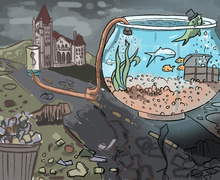Syracuse’s 4th down ineffectiveness evident after loss to No. 1 Clemson
Courtesy of Dennis Nett | syracuse.com
Despite being one of the best teams in the country on fourth down early in Dino Babers' tenure, Syracuse has struggled on fourth down throughout this season.
The Daily Orange is a nonprofit newsroom that receives no funding from Syracuse University. Consider donating today to support our mission.
The first of Syracuse’s two key fourth downs against No. 1 Clemson didn’t go as planned.
Receiver and kick returner Nykeim Johnson took the direct snap in the shotgun from SU’s own 45-yard line but didn’t even make it halfway back to the line of scrimmage. Safety Joseph Charleston got a free release and wrapped up Johnson just two steps into his power run.
It’s possible that failure was on head coach Dino Babers’ mind for the second notable fourth down, when he elected to punt one yard from a first down late in the third quarter on SU’s 41-yard line, his team down 27-21. It would’ve been an aggressive call, but dethroning the best team in the nation doesn’t happen with tentative game management.
This season, Syracuse (1-5, 1-4 Atlantic Coast) is 3-for-12 on fourth downs, 85th out of 92 teams who have played in 2020. Syracuse’s ineffectiveness on fourth downs must have informed Babers’ decision to punt on his own 41-yard line down 27-21 against Clemson.
With analytics suggesting teams should be more aggressive in fourth-and-short situations, the Orange have fallen behind. It’s one of many issues plaguing them this year, but it’s not an anomaly. Last year, they were worst in the ACC in fourth down conversion rate.
“Obviously, you want a better percentage than what we have,” Babers said. “But if we want to go for it, we’re going to go for it.”
When asked about his play-calling philosophy on fourth down situations, Babers used one word: Unpredictable.
On Syracuse’s 12 fourth down attempts this season, the Orange have gone for it inside its opponents’ red zone four times. But they’ve only converted once, on a Markenzy Pierre dive up the middle that got two yards against Georgia Tech. SU has gone for it twice in their own territory, once on the 49 and once on its 45-yard line.
“Sometimes it’s a flow of the game type thing,” Babers said.
Two of Syracuse’s three conversions came on crossing routes with Rex Culpepper behind center. On fourth down throws, SU quarterbacks are 2-for-4 for two first downs, though one attempt was on a 4th and 10.
Across football, teams have become more aggressive in fourth-and-short situations. The New York Times created a Fourth Down Bot that uses expected points and probability to determine when NFL teams should and shouldn’t go for it. Usually, being aggressive pays off.

Yiwei He | Design Editor
College teams are even more aggressive than NFL ones. Between 2016 and 2019, college coaches opted to go for it on 4th and 3 or closer on their own side of the field 16% of the time, while NFL teams did so 9% of the time, according to Sharp Football Analysis. Those numbers jumped to 65% and 45%, respectively, on the same down and distance in plus-territory.
One theory to explain that difference is that college kickers are typically less accurate than NFL ones. The college game is also generally higher scoring, so an offensive possession may be more valuable than flipping field position.
“I think the coolest thing is our defense knows that (we’re aggressive),” Babers said. “They don’t freak out, whether we’re going for it on the 19-yard line, the 41-yard line, minus-41 or the plus-2, plus-3. They know that we go for it on fourth down.”
Though several factors, including the nature of an individual game, dictate decision-making, Babers has typically been aggressive at Syracuse. In two of the past three seasons, the Orange have been in the top-15 in the nation in fourth down attempts, including second in 2017 with 38. That year, SU converted 57% with mobile quarterback Eric Dungey.
Now without Dungey and with a less talented offensive line, SU has struggled.
In Syracuse’s season-opener in Chapel Hill, the Orange drove down the field halfway through the first quarter, trailing 7-0. Facing a 4th and 1 on North Carolina’s 22-yard line, Babers called a read option. Quarterback Tommy DeVito kept the ball and sprinted off tackle to his left, but UNC linebacker Tomon Fox instantly dragged him down for a loss and a turnover on downs.
DeVito’s a solid athlete, but he’s not nearly as elusive as Dungey was. The redshirt junior was 0-for-2 on fourth down conversions with his feet before his injury against Duke.
The inside run is a staple on fourth-and-short situations, regardless of a quarterback’s rushing ability. SU has run up the gut on five 4th and shorts, converting only once. Against Liberty, Syracuse lined up in the I-formation on the Flames five-yard line. Freshman running back Sean Tucker, who’s averaging 5.1 yards per carry, bulldozed into his own blockers, who failed to create a running lane.
The play was indicative of Syracse’s situational football in 2020. No matter how creative or straightforward the play call, no matter how productive or ineffective the player had been, the Orange have found themselves going backward more often than not.

Published on October 27, 2020 at 10:35 pm
Contact Danny: dremerma@syr.edu | @DannyEmerman





